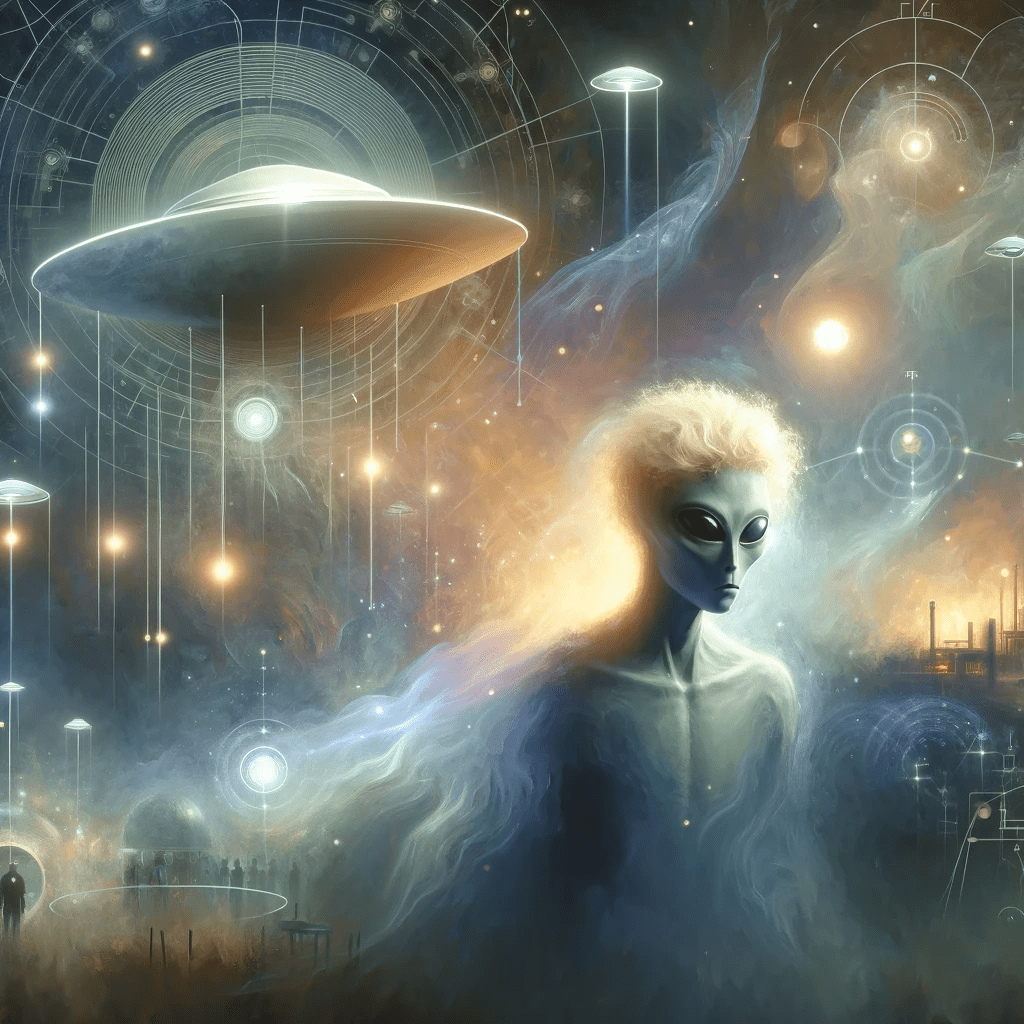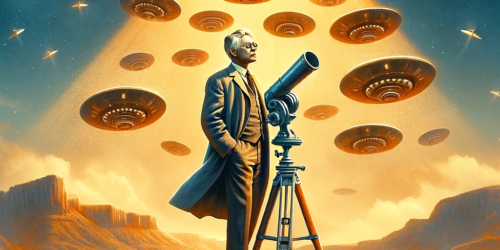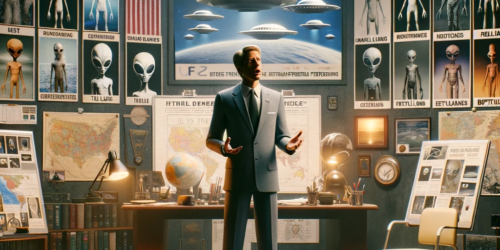Ronald Garner

C. Ronald Garner, a dedicated researcher in the field of UFOs for over 30 years, shared his extensive knowledge and insights in a poignant interview conducted approximately 30 days before his passing on March 14, 2015. The interview, captured by Chris Toussaint of Free Spirit Productions, was later released by the Mutual UFO Network (MUFON) on December 14, 2015. Garner’s discussion, conducted from a nursing home where he was in hospice care, looks into his lifelong fascination with UFOs, his interactions with insiders from the secret government, and his efforts to bring undisclosed documents to the public eye.
Ronald Garner explains the significance of his cap, adorned with an angel, as a “code image” for people involved in the secret program related to UFOs and extraterrestrial research. He mentions that the cap’s design carries a specific meaning known to those within the program, suggesting that it serves as a subtle form of communication or identification among insiders.
Garner’s journey into the realm of UFO research began in his teenage years, sparked by a book on flying saucers given to him by a neighbor. This early interest grew into a deep commitment, leading him to become an astrologer’s assistant and look into the world of transmediumship through his first wife, who channeled entities from other star systems. These personal experiences laid the foundation for Garner’s later research and encounters within the UFO community.
One pivotal moment in Garner’s career came in 1983 when he learned about Area 51 through a colleague whose brother worked there. This encounter, along with subsequent revelations by whistleblowers like Bob Lazar and insights from speakers at UFO conferences, deepened his understanding of the secretive activities at Area 51 and its subsidiary, S4. Garner’s recounting of these experiences provides a glimpse into the clandestine world of UFO research and back-engineering projects conducted by the U.S. government.
Ronald Garner describes S4 as a highly secretive location associated with UFO research and back-engineering projects. According to Garner, S4 is situated 15 miles southwest of Groom Lake, distinguishing it from Area 51 proper, which is part of Nellis Air Force Base. He emphasizes the distinction between Area 51, known for its conventional military activities including the presence of B-52s, and S4, where “super-secret stuff” is conducted. Garner’s description highlights S4 as a central hub for advanced and undisclosed research involving extraterrestrial technology and beings.
Ronald Garner recounts a significant anecdote involving Edward Teller, a prominent physicist known as the “father of the hydrogen bomb.” Garner shares that Bill Uhouse, an engineer who worked on back-engineering projects related to extraterrestrial technology, revealed that Edward Teller was present at Los Alamos with two beings from a different star system, described as the blond, blue-eyed variety often referred to as “Nordics” in ufology. These beings were reportedly teaching Edward Teller about their advanced science, bridging knowledge from their civilization to ours.
Ronald Garner addresses the concept of a “breakaway civilization” and introduces his own term, “ET fifth column,” to describe the intricate and covert interactions between humans and extraterrestrial beings. He references the work of Richard Dolan, who coined the term “breakaway civilization” to describe a highly advanced, secretive group that has access to extraterrestrial technologies and knowledge, which enables them to operate independently of conventional societal structures.
Garner expands on this idea by suggesting that the presence and influence of extraterrestrial beings on Earth constitute a “fifth column” — a group within a country that is sympathetic to or working for its enemies. In this context, Garner implies that these extraterrestrial influences are deeply embedded within various aspects of human civilization, including government, military, and scientific institutions. He posits that these beings are not only interacting with humans but are also shaping human affairs from within, influencing decisions related to finance, warfare, and other significant areas.
This perspective offers a radical reinterpretation of human-extraterrestrial interactions, suggesting that the relationship is not merely one of observation or occasional contact but involves a deep, systemic integration of extraterrestrial influences within human civilization.
Garner’s narrative also touches upon his interactions with individuals deeply embedded in the secret government, including those who have witnessed extraterrestrial beings and participated in advanced technological projects. He emphasizes the importance of understanding the interactions between humans and beings from other star systems, suggesting that these relationships have profound implications for humanity.
Ronald Garner speaks highly of Dan Burisch, offering a strong endorsement of Burisch’s credibility and contributions to UFO research. Garner describes Burisch as a microbiologist who worked for the Department of Defense and was deeply involved in projects related to extraterrestrial technology and beings. He specifically mentions Burisch’s interactions with a being from another star system, referred to as the “J-Rod,” and Burisch’s role in taking tissue samples for research purposes.
Garner highlights Burisch’s intelligence and dedication, noting his high IQ and his significant role within the secret programs dealing with extraterrestrial matters. He also touches upon the personal sacrifices and risks Burisch faced due to his involvement in these highly secretive projects, implying that Burisch’s insights and experiences are both valuable and hard-won. Garner shares an anecdote about Admiral J. Michael McConnell’s protective stance towards Burisch, suggesting that McConnell viewed Burisch as a valuable asset and sought to safeguard his well-being within the context of their secretive work. This portrayal underscores Garner’s respect for Burisch’s work and character, positioning him as a key figure in the ongoing efforts to understand and engage with extraterrestrial technologies and beings.
Ronald Garner discusses the “Looking Glass” technology in the context of his conversations about secret government projects and extraterrestrial interactions. He describes Looking Glass as a device that the secret government possesses, which has the capability to view probable futures or past events. According to Garner, this technology is not precise but can provide approximate scenarios of future events or insights into past occurrences. Additionally, Garner mentions that when the Looking Glass device is oriented at a 90-degree angle, it can also function as a teleportation device. This aspect of the technology suggests it has multifaceted uses, including both viewing temporal events and potentially transporting objects or beings across space.
Ronald Garner discusses the “Clean Sphere” in the context of his narrative about secret government facilities and their interactions with extraterrestrial beings. He describes the Clean Sphere as a Half Dome-like structure in which the atmosphere is controlled to mimic Earth’s, but with a crucial addition of 5% hydrogen. This specific atmospheric condition was created to accommodate a being from another star system, particularly from the Zeta Reticuli system, which Garner mentions in connection with the J-Rod, an extraterrestrial being involved in secret government projects. The Clean Sphere was needed to ensure the survival and comfort of this extraterrestrial visitor, as the being’s physiological requirements differed from humans’. The inclusion of hydrogen in the atmosphere was a critical adaptation to support the alien’s life processes, underscoring the lengths to which these secret projects would go to facilitate interaction and communication with extraterrestrial entities.
Ronald Garner looks into the intriguing notion that Adolf Hitler and Nazi Germany were involved in channeling activities with extraterrestrial beings, specifically mentioning “blonde Nordics.” According to Garner, these beings, often depicted as tall, blonde, blue-eyed entities in ufology, were supposedly in communication with Hitler and the Nazi regime, imparting advanced scientific knowledge and possibly influencing their technological advancements during the period leading up to and during World War II.
Garner suggests that this alleged extraterrestrial influence might explain the rapid technological developments in Nazi Germany, including their efforts in rocketry and potentially in anti-gravity technology. He alludes to the idea that the Nazis’ contact with these “Nordic” aliens could have provided them with insights far beyond the scientific understanding of the time, contributing to the lore of Nazi involvement with mysterious and advanced technologies.
Ronald Garner touches on the subject of Adolf Hitler’s interest in esoteric and occult literature, suggesting that Hitler had amassed a significant collection of such materials. According to Garner, this collection likely included texts on UFOs, extraterrestrial beings, and advanced technologies, which could have influenced Nazi ideologies and their pursuit of unconventional scientific advancements.
Furthermore, Garner introduces the claim that the Rockefeller family, known for their significant influence in various sectors including finance, education, and philanthropy, allegedly took steps to obscure the connection between Hitler’s esoteric interests and his regime’s technological pursuits. Garner implies that there was an effort to prevent this aspect of Hitler’s interests from becoming widely known or acknowledged in historical accounts, potentially to detach the narrative of advanced technological research from the occult and extraterrestrial influences that Garner suggests were at play.
In his final interview, Garner expressed a desire to see his findings published in the MUFON Journal, hoping to spark further investigation by other researchers. He revealed plans to provide Bob Wood and Jan Harzan with documents that could potentially unveil more about the inner workings of the secret government and its dealings with extraterrestrial entities.
Garner’s interview is not just a recounting of his personal journey but also a call to action for the UFO research community. He urged researchers to consider the broader implications of human-extraterrestrial interactions and to pursue lines of inquiry that could shed light on the complex relationship between our world and others. Garner’s legacy is one of curiosity, dedication, and a relentless quest for truth, even in the face of the unknown. His contributions to the field of UFO research continue to inspire those who seek to understand the mysteries of the universe and our place within it.



